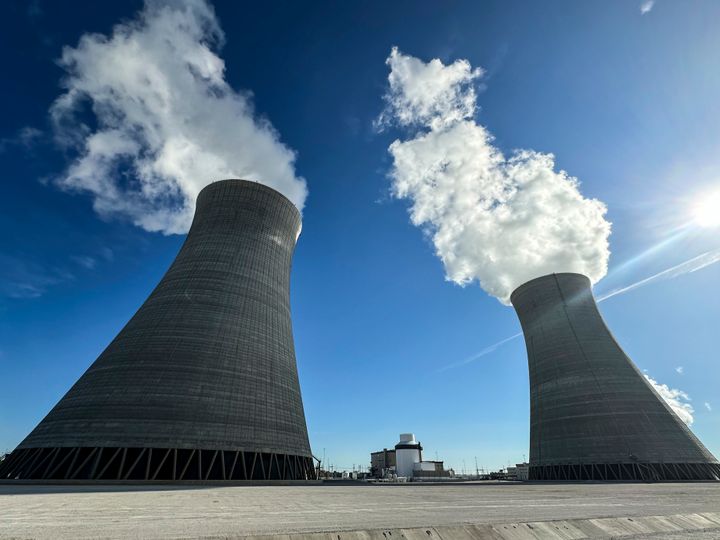The Senate voted nearly unanimously Tuesday evening to pass major legislation designed to reverse the American nuclear industry’s decades-long decline and launch a reactor-building spree to meet surging demand for green electricity at home and to catch up with booming rivals overseas.
The bill slashes the fees the Nuclear Regulatory Commission charges developers, speeds up the process for licensing new reactors and hiring key staff, and directs the agency to work with foreign regulators to open doors for U.S. exports.
The NRC is also tasked with rewriting its mission statement to avoid unnecessarily limiting the “benefits of nuclear energy technology to society,” essentially reinterpreting its raison d’être to include protecting the public against the dangers of not using atomic power in addition to whatever safety threat reactors themselves pose.
“It’s monumental,” said John Starkey, the director of public policy at the American Nuclear Society, a nonprofit of academics and industry professionals that advocates for atomic technology in the public interest.
The NRC, he said, “is a 21st century regulator now.”
“This has been a long time coming,” Starkey said.
In a rare show of bipartisan unity on clean energy, the House of Representatives voted 365 to 36 last month to pass its version of the legislation, called the ADVANCE Act. All but two senators — Bernie Sanders (I-Vt.) and Ed Markey (D-Mass.) — supported the bill in Tuesday’s vote. The proposal will now go to the White House, where President Joe Biden is all but certain to sign it into law.
It is widely considered the most significant clean-energy legislation to pass since the president’s landmark Inflation Reduction Act of 2022.
“Republicans and Democrats recognize the development of new nuclear technologies is critical to America’s energy security and our environment,” Sen. Shelley Moore Capito (R-W.Va.), the bill’s lead sponsor, said on the Senate floor Tuesday evening. “Today, nuclear power provides about 20% of our nation’s electricity. Importantly, it’s emissions-free electricity that is 24/7, 365 days a year.”
The U.S. led the world in developing nuclear energy in the 1950s and went on to build by far the largest fleet of power plants, with more than 110 reactors providing more than one-fifth of America’s electricity. But as growth in electricity demand slowed in the 1970s and public concern over radiation issues grew, utilities struggled to afford the high cost of building new reactors.
As climate change put a new premium on nuclear energy’s massive output of low-carbon electricity, the U.S. looked to restart its reactor program in the early 2000s. But right as the cost of first-of-a-kind projects ballooned into the billions of dollars, the U.S. saw a drilling boom that increased the domestic supply of cheap natural gas. Coupled with inexpensive wind turbines and solar panels from overseas, U.S. nuclear companies lost deals to supply power. As a result, more than a dozen reactors have shut down over the past decade and just two new reactors were built.
That pair of reactors, which just came online last month at the Alvin W. Vogtle Electric Generating Plant in Georgia, cost more than $30 billion. As the expenses mounted, other projects to build the same kind of reactor elsewhere in the country were canceled.

The timing could hardly have been worse. After completing the first reactor, the second one cost far less and came online faster. But the disastrous launch dissuaded any other utilities from investing in a third reactor, which economists say would take even less time and money now that the supply chains, design and workforce are established.
Now that the two new reactors have turned the so-called Plant Vogtle into America’s most powerful generating station, with enough 24/7 clean electricity to serve more than 1 million households, there are no more reactors of that kind in the pipeline.
“As successful as Vogtle 3 and 4 are ― and they’re incredibly successful ― we should ask ourselves the question, why didn’t we lay the groundwork to proceed from those two units to 20 more?” Jeff Lyash, the chief executive of the federally owned Tennessee Valley Authority utility, said June 17 during a panel at an industry conference in Las Vegas. “Why are we sitting in this gap trying to figure this out? That’s the question we have to answer.”
Though it may not contain all the answers, the ADVANCE (Accelerating Deployment of Versatile, Advanced Nuclear for Clean Energy) Act would make it easier to build multiple reactors at the same site by easing NRC regulations on the second, third and fourth units.
“This bipartisan policy creates the framework for companies to start building that order book for a second project and a third project and ultimately get the NRC ready to license dozens per year,” said Nicholas McMurray, the managing director of international and nuclear policy at energy policy group ClearPath.
The nuclear industry has a long way to go to line up the financing and construction crews needed to build new reactors at the speed and efficiency seen in China, Russia or the United Arab Emirates. But lining up multiple orders at a time, and making it easier to permit more than one reactor at the same site, could be a help to whatever company ends up building the next large-scale reactor like the ones completed in Georgia. Yet the nuclear energy bill is specifically tailored to boost types of reactors that are not currently in commercial production in the U.S.
Virtually all commercial reactors around the world generate electricity by using heat released from splitting unstable uranium atoms to turn water into steam to spin turbines in a generator. Newer designs aim to use liquid metal or a high-temperature gas as a coolant instead, allowing reactors to run on different types of fuel that produce less radioactive waste and operate in more settings than a traditional nuclear plant.
In recognition of these so-called fourth-generation reactor models’ unique uses, the bill would authorize the Department of Energy to give out financial awards to the first companies to meet specific goals, such as using fuel made from recycled nuclear waste or generating heat that could be used for things other than electricity production.
The bill would also give the NRC power to hire key staffers more quickly and at higher rates than the federal government usually does, allowing the agency to compete more directly with private companies for employees.
The legislation marks the biggest change Congress has made to U.S. nuclear regulations since then-President Richard Nixon signed the 1974 law establishing the NRC and disbanding the Atomic Energy Commission, which was seen as too promotional of the industry it oversaw.
A law enacted in 1982 set the groundwork for how the U.S. deals with nuclear waste. A 2005 statute added new security measures and pumped money into researching reactors. In 2019, Congress passed a bill directing the NRC to update its approach to newer types of technologies.
Then, in 2022, Biden signed his historic infrastructure-spending laws that directed billions of dollars to test, restart and run nuclear reactors, including reopening plants that had been shut down for financial reasons.
But the provisions in the ADVANCE Act are designed to encourage utilities to order and build new reactors in bulk, a step analysts say will help lower the cost and make U.S. nuclear energy technology competitive with Russia and China again.
“This is a huge win for our climate, economic and energy security goals,” said Farah Benahmed, a policy manager at energy group Breakthrough Energy, which is backed by billionaire Bill Gates.
Yet it’s only a first step. The full legislation depends on Congress increasing funding to the NRC to make up for the lost revenue from licensing fees, help the agency staff up for an expected influx of applications and fund more diplomatic missions overseas.
The bill’s supporters have pitched the legislation as essential to making the U.S. competitive with Russia and China in the race to build the first reactors in newcomer countries such as Ghana, the Philippines and Saudi Arabia. Though the fees that U.S. companies pursuing deals abroad pay to the NRC have historically funded officials’ trips overseas, the legislation gives the agency a clear mandate to look abroad for ways to help allied countries adopt the American regulatory playbook.
Critics of the bill say it risks exporting poorer safety practices.
“Make no mistake: This is not about making the reactor licensing process more efficient, but about weakening safety and security oversight across the board, a longstanding industry goal,” Edwin Lyman, the director of nuclear power safety at the watchdog Union of Concerned Scientists, said in a statement.
“Passage of this legislation will only increase the danger to people already living downwind of nuclear facilities from a severe accident or terrorist attack, and it will make it even more difficult for communities to prevent risky, experimental reactors from being sited in their midst.”
Speaking in support of the legislation Tuesday, Senate Majority Leader Chuck Schumer (D-N.Y.) said the bill would “support job growth, clean energy and leadership while preserving the NRC’s fundamental” safety mission.

At the same American Nuclear Society conference in Las Vegas, Southern Co. CEO Chris Womack, whose utility giant built the two new reactors in Georgia, warned that any future projects still depend on the federal government providing more money and financial backing.
“What I hear you saying, Chris, is there needs to be more than what we’re putting on the table, and that’s hard to hear because we’ve just put billions and billions and billions on the table,” Energy Secretary Jennifer Granholm, a fellow panelist, said in response. “I don’t know what the delta is between what you think is necessary and what it would actually take to build up.”
Asked at the end of the panel when the U.S. would see its next large-scale reactors planned, Granholm, Womack and the TVA’s Lyash all said announcements would come in the next few years.
Meanwhile, one of those new advanced reactors is finally breaking ground.
Last week, Gates flew to Wyoming for the groundbreaking of his TerraPower startup’s first liquid salt-cooled reactor at a coal plant. It’s the kind of thing that could be helped by the ADVANCE Act’s funding for research on how to turn coal stations into nuclear plants and by support for “fourth-generation” reactors in bulk.
TerraPower had initially planned to build its first reactor in China, which is currently building more reactors faster than anyone else and is on pace to surpass the U.S. within a decade. Gates’ company canceled its plan as the U.S. slapped trade restrictions on Beijing in 2019.
Beating out TerraPower, China launched the world’s first commercial fourth-generation reactor in December ― and now, according to a recent study, “likely stands 10 to 15 years ahead of the United States in its ability to deploy” the technology.
Disclaimer: The copyright of this article belongs to the original author. Reposting this article is solely for the purpose of information dissemination and does not constitute any investment advice. If there is any infringement, please contact us immediately. We will make corrections or deletions as necessary. Thank you.
